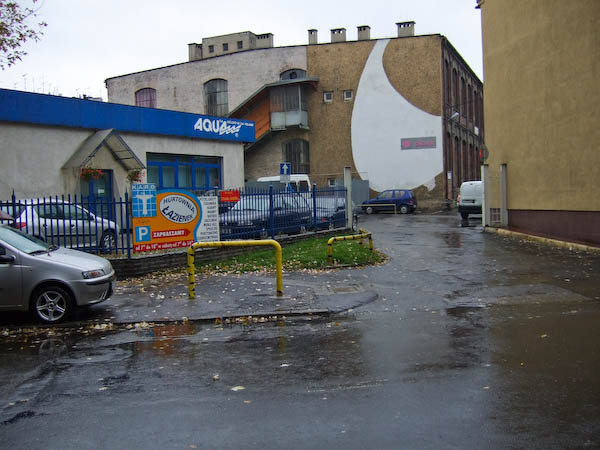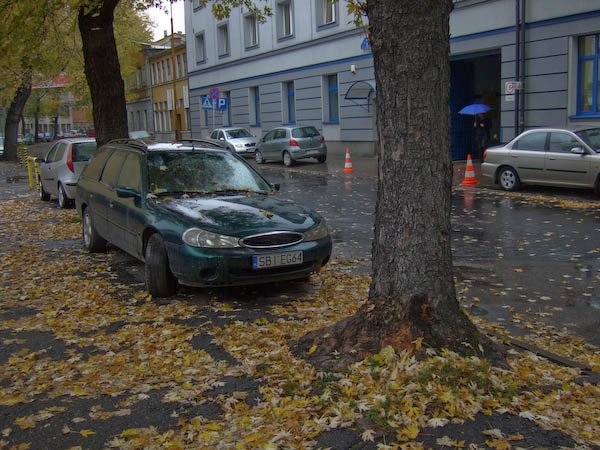FotoArtFestival 2007
In 2005 I was invited to show my photographs from the London's
Industrial Heritage site at the first ever FotoArtFestival
held in Bielsko-Biala, Poland.
This was a highly successful event, with work by some of the best
photographers from around the world - one from each of 25 countries,
including some well-known names - such as Eikoh Hosoe,
Ami Vitale, Boris Mikhajlov and Malick
Sidibe, as well as many rising stars and a few of those no
longer with us, Mario Giacomelli, Inge Morath
and Robert Diament.
The 26 major shows were truly an effort to be international, although
concentrating on European countries, including Albania, Austria,
Belgium, Czech Republic, Denmark, Finland, Germany, Holland, Hungary,
Italy, Latvia, Lithuania, Poland, Russia, Slovakia, Spain, Sweden,
Turkey, the Ukraine and of course my work from the UK, as well Iran,
Japan, Mali, South Africa and the USA. France and Switzerland. Alongside
this were some other shows and events by Polish photographers.
Attendances for the festival were relatively small, making it more
human and friendly than some large and well-established festivals, and
for those who took part it was an experience we will not forget.
The 2007 Festival built on the experience gained, and the organisation
was noticeably better in many ways, with the photographers being
extremely well looked after and generally superb hanging and lighting of
the shows.
There were slightly less shows - and fewer invited artists, which made
the series of presentations - the Artists' Marathon, a little easier to
fit in the two days, although some minor technical problems with the
venue did hold things up.
This year the emphasis was on showing different approaches to the
medium, with a good showing of exhibitors from central europe. The
exhibiting artists were Michal Macku (Czech Rep), Karol
Kallay (Slovakia), Stasys Eidrigevicius
(Lithuania/Poland), Aleksandras Macijauskas (LIthuania),
Michael Kenna (UK), Walter Rosenblum
(USA), Jose Luis Raota and Pedro Luis Raoto (Argentina),
Franco Fontana (Italy), Judit M Horvath
and Gyorgy Stalter (HUngary), Joan
Fontcuberta (Spain), MIsha Gordin
(Latvia/USA), Lukas Maximilian Huller (Austria), Sarah
Moon (France), Alex ten Napel (Holland), Mitra
Tabrizian (Iran/UK) and Dalang Shao, Du
Shao and Jiaye Shao(China), along with a
show of the work of the Polish Photoclub 1929-39 and
some accompanying - mainly open -shows.
I was invited to the festival to speak, and I'll also post a version of
the performance I gave, using pictures by nine photographers, including
some of my own work from My London Diary.
For copyright reasons I can't include the illustrations by other
photographers, but where possible I'll link to similar work on the web.
There will also be some differences in the text, parts of which I do not
have permission to use on the web, and some of which was unscripted.
There will also be some explanatory notes and material which was omitted
because of time restraints. Unfortunately the written version will only
be in English.
As well as my 'On London Streets' which concluded the
'Artists Maraton', there was also a lecture on the 'New
York Photo League' by photo-historian Naomi Rosenblum
and Nina Rosenblum presented her film about her father,
'Walter Rosenblum: In Search of Pitt Street'.
I didn't have time to see quite all the shows, but over the next few
weeks I intend to write a little about those I did see, on the
>Re:PHOTO blog.
On this site will be an edited version of my diary, illustrated by some
of the pictures I took, of the city of Bielsko-Biala, the events and the
photographers.
My Diary
I set off from home at around 7.15 to catch the local bus to Heathrow.
Half-way to the stop I panicked - did I have my passport and tickets? I
stopped, searched my pockets and couldn't find them.
I thought I must have left them at home and ran back, but frantic
searching failed to find them. Then I remembered the carefully hidden
security pocket in my jacket, looked in it and found I had them with me
all the time.
I ran back to the bus stop, reaching it just in time to see the bus
disappearing along the road. Half an hour to wait for the next one.
Fortunately it came on time, and I arrived at the check-in desk in
plenty of time, if not quite the two hours that Heathrow expects.
Fortunately I got through the security check without any hitches, not
even asked to prove my need for the syringe and needles, not a glance at
the liquids in their plastic bag. Probably by now the staff know that
the scare about them was always pure fiction. And I settle down to read
a rather more satisfying fiction, Doris Lessing's 'The Golden
Notebook' in the departure lounge. It's a very thick work
(although Nobel Prizes are not awarded by weight.)
The edition starts with a preface by the author, that looks at the role
of critics and the way that literature is abused by education, which
rather than teaching students to appreciating it forces them to
concentrate on peripheral aspects. I think how much some of her comments
apply to photography also, where the deadening academic hand virtually
throttled photography - especially in the UK - in the 1980s and 90s, and
still festers its poison across the medium. Not that I'm predjudiced
against it of course!
The preface impressed me greatly (and so did the rest of the book.)
Later I decided to read a small section from it at the start of my
presentation.
I hate flying. Cramped, uncomfortable seats, noise and vibration, and
painful popping of the ears that leaves me aching and half deaf for
days.
Warsaw aiport is a shambles. I need to transfer from the international
arrivals to the domestic departures, and follow the signs. I'm in a
hurry because the flight from Heathrow was delayed and its approaching
the time I should be at the boarding gate.
Before long I'm lost in a car park with nothing to tell me which way to
go, but I can see the domestic arrivals and have to walk along the road
to get there. I ask someone where the departures are, and find the doors
are just around the corner - but hidden from sight until I walk a yard
or two further.
Then, despite the fact this is a transfer, I have to queue for 10
minutes to go through another security check, this time being told to
remove shoes, belt, watch and everything from my pockets.
At last I'm in the departure area (its hardly a lounge) and my flight
is listed on a screen, but with no other information about it.
Eventually it moves from one screen to another, but still no
information. The flight time comes closer and close, then eventually it
gets marked as delayed. I get talking to an American and find he is
going to run a workshop as an entertainer - I think to do with puppets.
Other flights go and we are still waiting, but finally the Krakow
departure is called and we file up to the checking desk and then on to
the bus, which eventually takes us across the tarmac to the plane.
The flight is very noisy; somehow I'd expected it to be quieter as the
plane had propellers, but it was smaller, a little more cramped and
noisy, and I was very pleased to land at Krakow, despite the deafness
and the pain in my ears from the pressure changes.
I'm even more pleased to walk through the barriers and see a guy
holding up a sign reading 'Peter Marshall' and 'Misha Gordin'. I go up
and introduce myself, and a minute later Misha arrives. I'd expected two
others going to the festival to be on the same flight, but their travel
plans have changed, so it is just Misha and I who get in the car to be
driven to the hotel in BIelsko-Biala.
Its a slow drive over back roads, and it soon gets too dark to see much
over the windows. I let Misha sit in front, and in the back I'm still
pretty deaf and finding it a strain to join in the conversation,
although we exchange some basic details. Misha has been travelling for
over 24 hours from somewhere in the backwoods near Minneapolis, which
makes my journey seem pretty easy.
When I walk into the foyer of the hotel, Inez is there waiting and we
greet each other warmly; it really is so good to see her again. We check
in and I ask about food, and Inez says she will take us to the
restuarant - when we've got ourselves sorted out.
My next surprise is that we are then introduced to our volunteer guides
who are going to look after us during our stay. I'm delighted to meet
Kate (Katarzyna), as on my first visit I did rather get lost, and it's
great to be looked after. We are also given the festival goody bag, with
catalogues etc, and also a huge calendar with pictures from the 2005
festival.
Its good to have this, but I also immediately think however am I going
to get this home, and hope that the Poles are rather more sensible than
the security at Heathrow.
Ten minutes later I'm freshened up slightly and down in the foyer ready
for some dinner. Inez introduces me to the photographer Jose Luis Roata
from Argentina who has been in Poland for a few days helping to hang the
shows and says "We're just waiting for Sarah Moon."
And so I get to meet Sarah Moon, one of the most famous models of the
1960s, a fashion icon of the time, whose picture surely featured among
the many women pasted on my bedroom wall in the huge collage of my late
teenage years.
Who then became a famous fashion photographer, and also produced
fascinating series of images, in particular re-telling the stories of
Hans Christian Anderson and other fictions, as well as making many
films, not least one about Henri Cartier-Bresson, who was a friend of
hers.
Sarah reminds me very much of me of her pictures, and speaks perfect
English with only a slight accent, as she spent her early years in
England where her family were during the war.I don't think we talk much
if at all about her work, but we do seem to find plenty of things to
talk about, both squashed together in the back of the car and also over
dinner in the restuarant. I even find I can tell her a little about
Paris that she doesn't know, or at least about the banlieue.
It's interesting too to learn more about Misha and in particular about
his ideas about freedom and America, which we had already begun to
explore duing the car ride from the airpost.
The restuarant is the oldest in Bielsko, nineteenth century with high
ceilings and very old-fashioned. I have beetroot soup with a croquette
as a starter and it is delicious, although the chicken main course is a
little disappointing.
Apart from Sarah and Misha, few of the other photographers had yet
arrived. I was tired after my journey, so decided on an early night
after dinner rather than a trip to a bar.
(continued on next page.)
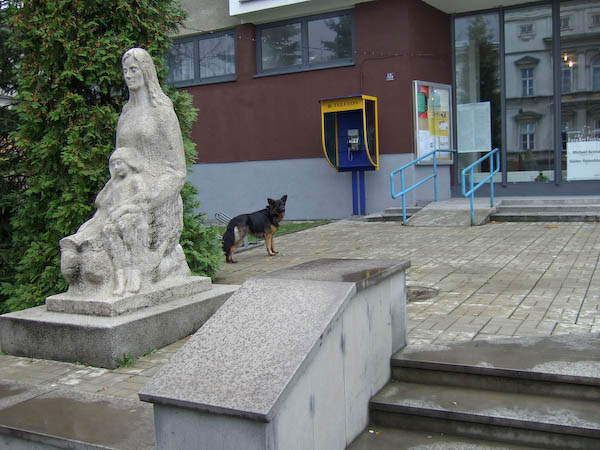
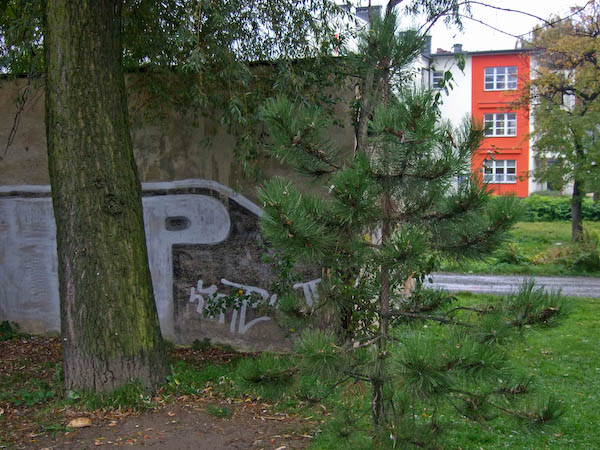
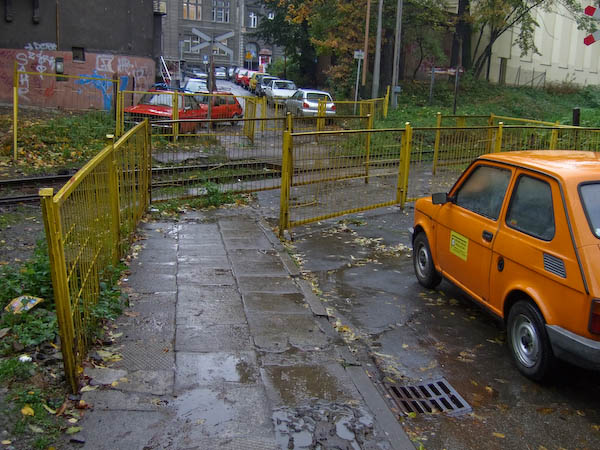
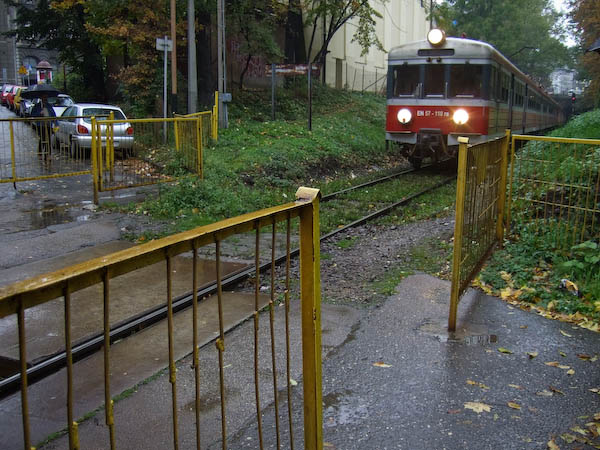
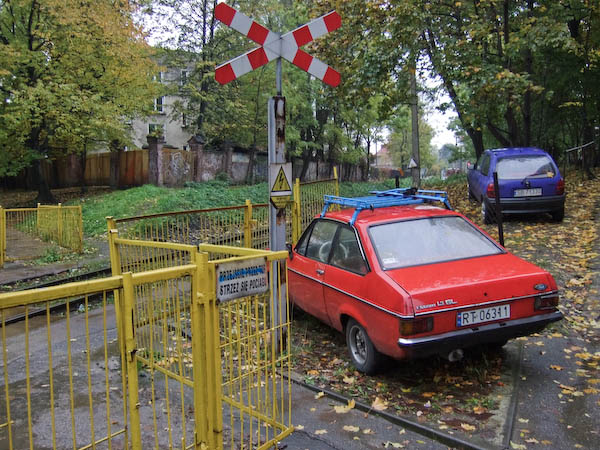
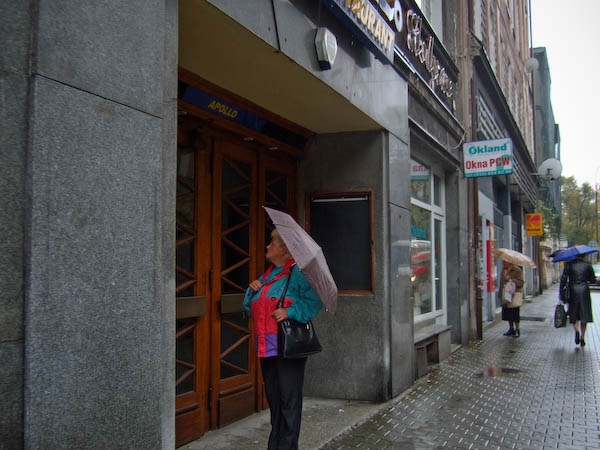
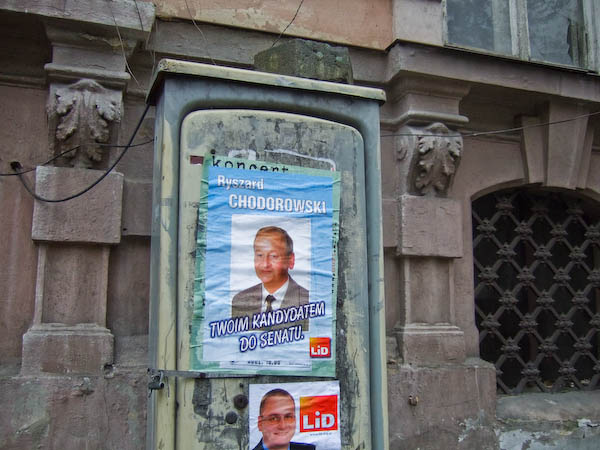
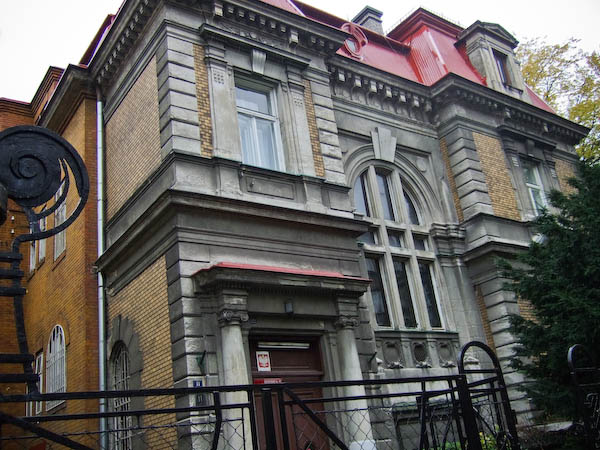
 I was a
little early, so I wandered down the road past the gallery
I was a
little early, so I wandered down the road past the gallery